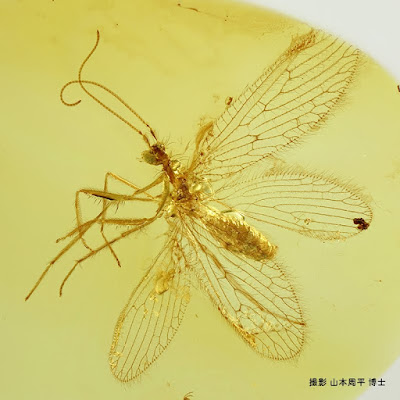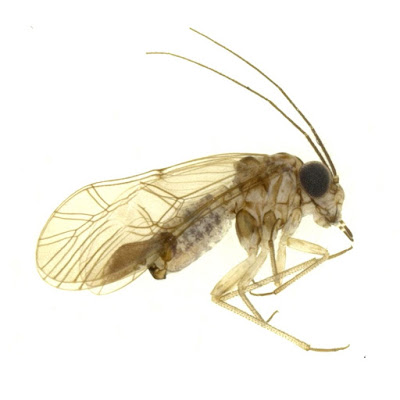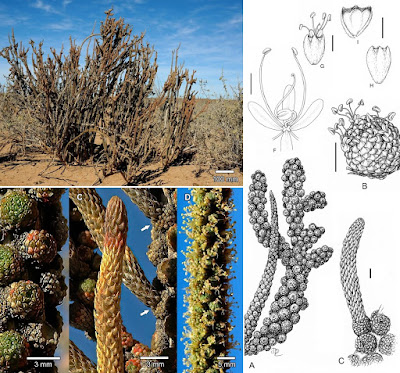[Most Recent Entries] [Calendar View]
Monday, April 20th, 2020
| Time | Event | ||||||
| 2:12a | [PaleoEntomology • 2020] Hidden Diversity of Small Predators: New Thorny Lacewings (Neuroptera: Rhachiberothidae: Paraberothinae) from mid-Cretaceous Amber from northern Myanmar
Abstract Thorny lacewings (Rhachiberothidae) are currently distributed only within Africa, whereas they are prevalent in the fossil record of various Cretaceous ambers across the Northern Hemisphere, with a handful of the fossil records from some Eocene European ambers. Four rhachiberothid species in four extinct genera are known from the mid-Cretaceous amber of northern Myanmar. Here, we report further examples of the remarkable palaeodiversity of this group from the same amber deposit, adding the four new fossil genera and seven new species: Acanthoberotha cuspis gen. et sp. nov., Astioberotha falcipes gen. et sp. nov., Stygioberotha siculifera gen. et sp. nov., Uranoberotha chariessa gen. et sp. nov., Creagroparaberotha cuneata sp. nov., Micromantispa galeata sp. nov. and M. spicata sp. nov. Based on a series of well-preserved specimens, we discuss the fine details of the raptorial forelegs and genital segments, which may be important for elucidating the phylogenetic relationships among genera. Our findings reveal an unexpectedly diverse assemblage of thorny lacewings in the Cretaceous System, highlighting the morphologically diverse rhachiberothids in Burmese amber. The discovery of seven additional rhachiberothid species in Myanmar amber suggests the potential for much higher diversity and abundance of the Cretaceous rhachiberothids than previously documented. Furthermore, morphological variation in the raptorial forelegs was found to be extremely diverse among the Burmese amber paraberothines, especially in terms of the size, number and shape of spines (or spine-like setae) on the inner edges of protibia, and the morphological structure of the probasitarsus. Keywords: Mantispoidea, Rhachiberothidae, Paraberothinae, Myanmar, Cenomanian
Hiroshi Nakamine, Shûhei Yamamoto and Yui Takahashi. 2020. Hidden Diversity of Small Predators: New Thorny Lacewings from mid-Cretaceous Amber from northern Myanmar (Neuroptera: Rhachiberothidae: Paraberothinae). Geological Magazine. First View. DOI: 10.1017/S0016756820000205 | ||||||
| 3:24a | [Entomology • 2020] Symbiopsocus vietnamicus • The First Record of the Bark Louse Genus Symbiopsocus (Psocodea: Psocidae) from Vietnam, with Description of A New Species
Abstract The bark louse genus Symbiopsocus includes 23 species, all of which known from East Asia. Here we report the first record of Symbiopsocus from Vietnam, with description of Symbiopsocus vietnamicus sp. nov. A revised key to the species of Symbiopsocus is provided. Keywords: Psocodea, Psocomorpha, Psocinae, taxonomy, Indochina
Symbiopsocus vietnamicus sp. nov. Diagnosis. Male paraproct medially with a short scabrous lobe near trichobothrial field. Male hypandrium: dorsal lobe with lateral arm strongly protruding posteriad and with postero-medial region distinctly protruding, forming a pair of boot-shaped processes; ventral lobe lacking denticles, largely divided in two symmetrical parts, distally flattened and with a digitiform, acutely pointed process. Female external valve without posterior lobe Distribution. Vietnam (Vinh Phuc). Etymology. The specific epithet “vietnamicus” refers to the country of origin of this species. Remarks. This new species resembles S. leptocladus Li, 1997, S. subrhombeus Li, 2002 and S. quadripartitus Li, 2002 in having similar configuration of the male hypandrium (e.g. dorsal lobe with lateral arms protruding posteriad and with postero-medial region separated into a pair of projections, which are curved laterally at tip), it also appears to be similar to S. quadripartitus Li, 2002 in having similar phallosome (i.e. anteriorly and posteriorly both distinctly protruding). The new species can be distinguished from the above species by the ventral lobe of the male hypandrium, distally flattened with a digitiform process. There are six species of Symbiopsocus known with only females, i.e. S. unitus (Li, 2002), S. undulates (Li, 2002), S. nanyuensis (Li, 1992), S. magnificus (Li, 2002), S. latus (Li, 2002) and S. changbaiensis (Li, 2002). The new species can be distinguished from all these species by the female external valve without posterior lobe. Jinjin Ning, Fasheng Li and Xingyue Liu. 2020. The First Record of the Bark Louse Genus Symbiopsocus (Psocodea: Psocidae) from Vietnam, with Description of A New Species. Zootaxa. 4759(3); 413–420. DOI: 10.11646/zootaxa.4759.3.7 | ||||||
| 8:04a | [Botany • 2020] Tiganophyton karasense • From the Frying Pan: An Unusual Dwarf Shrub from Namibia Turns Out To Be, Tiganophytaceae, A New Brassicalean Family
Abstract Tiganophyton karasense, an evergreen dwarf shrub, is described as a new species. A new genus and family are also proposed for it in the order Brassicales. Phylogenetic analysis of DNA sequence data indicate that Tiganophyton is sister to Bataceae/Salvadoraceae, and all three sister to Koeberliniaceae. First realized to be undescribed in 2010, T. karasense is a rare species known only from three localities in the arid Karas Region, southern Namibia. These small shrubs grow near the edges of seasonal pans on calcareous substrate underlaid by shales and mudstones of the Prince Albert Formation of the Karoo Supergroup. Morphological characters diagnostic of the new family include: a marked differentiation into long and short shoots; dimorphic, spirally arranged leaves; glucosinolate production; bisexual laterally flattened flowers borne singly in bract axils on short shoots only; tetramerous calyx, corolla and androecium with fused sepals and free, non-clawed petals; a staminal disc, but no nectary glands; deeply bilobed ovary with a gynobasic style; S-shaped gynophore supporting a bilocular, horizontally orientated or inverted ovary; two ovules per locule; and a dry, persistent fruit, provisionally interpreted as a one-seeded nutlet. Based on IUCN Red List categories and criteria, a conservation assessment of Vulnerable (VU D1) is recommended for Tiganophyton karasense. Keywords: Bataceae, Brassicales, Koeberliniaceae, limestone, mudstone, seasonal pans, Karoo Supergroup, endemism, Karas Region, Salvadoraceae, taxonomy, Tiganophytaceae, Tiganophyton, Eudicots Tiganophytaceae Swanepoel, F.Forest & A.E.vanWyk, fam. nov. Type:–– Tiganophyton Swanepoel, F.Forest & A.E.van Wyk. A member of Brassicales, our new family is most closely related to Bataceae and Salvadoraceae and more distantly to Koeberliniaceae. It is morphologically distinct from these and all other known families of the order and easily distinguished by, amongst others, the following combination of characters (for a more comprehensive comparison, see Table 1): dwarf shrub with stems distinctly differentiated into long and short shoots; leaves minute, dimorphic, spirally arranged; glucosinolates present; flowers bisexual, laterally flattened, borne singly in bract axils on short shoots only; calyx, corolla and androecium tetramerous; sepals fused; petals free, not clawed; staminal disc (receptacle?) present; nectary glands absent; ovary deeply bilobed, apparently bilocular; gynophore present, bent in near S-shape; ovary horizontally orientated or occasionally inverted; style gynobasic; ovules two per locule; fruit a dry, persistent, oneseeded nutlet. Tiganophytaceae differ from Bataceae, Salvadoraceae and Koeberliniaceae by the distinct differentiation of vegetative axes into long and short shoots (vs. mainly long shoots), dimorphic foliage leaves (vs. monomorphic), fruit a nutlet (vs. berry or drupe), ovary bilobed and horizontally orientated or inverted (vs. not lobed and upright), and gynobasic style (vs. apical). It furthermore is easily distinguished from Bataceae by spirally arranged leaves (vs. decussate), hermaphroditic plants (vs. monoecious or dioecious), no stipules (vs. present, early deciduous), solitary flowers in bract axils (vs. in cone-like spikes), sessile petals (vs. long clawed in males; absent in females), gynophore present (vs. absent), and two ovules per locule (vs. one); from Salvadoraceae it differs also by having no stipules (vs. present), spirally arranged leaves (vs. opposite), solitary flowers in bract axils (vs. racemes, panicles or axillary fascicles), free petals (vs. basally fused), no nectar glands (vs. often present), and well-developed and near S-shaped gynophore (vs. absent or short and straight); from Koeberliniaceae it differs also by the lack of thorns (vs. present), solitary flowers in bract axils (vs. axillary umbel-like racemes), fused sepals (vs. free), sessile petals (vs. shortly clawed), four stamens (vs. eight, rarely ten), no separate nectar glands (vs. present), and two ovules per locule (vs. many). As families, Tiganophytaceae, Bataceae and Koeberliniaceae are morphologically distinct. However, our molecular evidence indicates that Bataceae are nested in Salvadoraceae (also Sun et al. 2016), making Salvadoraceae paraphyletic, but data on more taxa are needed to fully resolve the possible relationships among these families. A phylogenetic analysis of Brassicales inferred from 72 plastid genes by Edger et al. (2018) showed Salvadoraceae and Bataceae to be sisters, but this is of little significance for our use as it was based on a limited sampling of Salvadoraceae, with both Dobera and Azima absent. From a practical point of view, it would serve little purpose to create heterogeneous families with little or no predictive value, although some may argue that monotypic families do little in the way of summarizing information, perhaps preferring to opt for subfamily or tribal status. Considering available evidence for these families, indications are that the largest one, Salvadoraceae, is heterogeneous as currently circumscribed. For example, Azima is, amongst others, morphologically and anatomically distinct from other members of the family (e.g. Takhtajan 2009), and in the past has been placed in a family of its own, namely Azimaceae (Wight & Gardner 1845). However, Azima does share some morphological features with Batis, notably the possession of unisexual flowers (Ronse De Craene 2005) and an ovary with a false septum, albeit only an apical one (Kshetrapal 1970), as is also present in Dobera (Ronse De Craene & Wanntop 2009). Further studies should consider, amongst others, the possible reinstatement of Azimaceae, but alternatively it may be better to accommodate Azima in an expanded Bataceae or to subsume Bataceae in an expanded Salvadoraceae. Tiganophyton Swanepoel, F.Forest & A.E.van Wyk, gen. nov. Tiganophyton karasense Swanepoel, F.Forest & A.E.van Wyk, sp. nov. Type:— NAMIBIA. Karas Region: Groot Pan, 38 km northeast of Tses along road, on edge of pan, 2518CB, 1030 m, 19 December 2010, Swanepoel 365 (holotype WIND; isotypes PRE, PRU). Conservation status:— Tiganophyton karasense is rare and localized with only three locations known. It should be considered as Vulnerable (VU D1) due to its small population size, the latter estimated to number fewer than 1000 mature individuals (IUCN 2012). Etymology:— Tiganophyton is derived from the Greek τηγάνι, tigani, a frying pan, referring to the habitat of this species, which can be extremely hot, and φυτών, fyton, a plant. The specific epithet “karasense” denotes the Karas Region in southern Namibia, where all known localities of the new species are located. Wessel Swanepoel, Mark W. Chase, Maarten J.M. Christenhusz, Olivier Maurin, Félix Forest and Abraham E. E. van Wyk. 2020. From the Frying Pan: An Unusual Dwarf Shrub from Namibia Turns Out To Be A New Brassicalean Family. Phytotaxa. 439(3); 171–185. DOI: 10.11646/phytotaxa.439.3.1 | ||||||
| 10:11a | [Herpetology • 2020] Physalaemus claptoni • A New Species of the Physalemus deimaticus Group (Anura, Leptodactylidae) [Amphibians from Serra do Cipó, Minas Gerais, Brasil. VI]
Abstract We describe a new species of Physalaemus assigned to the Physalaemus signifer Clade, and it is morphologically similar to P. rupestris, from the highlands of the Serra do Cipó in the southern Espinhaço Range, State of Minas Gerais, Southeastern Brazil. The new species is diagnosed by using the following combination of character states: presence of an arrow-shaped blotch on the dorsum of body; presence of a median longitudinal light stripe over urostyle region; belly and ventral surface of thigh marbled with dark gray irregularly shaped blotches on a bluish background; absence of reddish coloration over axillary and inguinal regions in live individuals; bright orange dots scattered over head, upper lip, and dorsum of body in live individuals; ventral surface of hand and foot red in live individuals; small size (adult male SVL=16.2–18.2 mm); presence of brown, not divided, nuptial pad in males; END/ED in males ranging from 0.85–0.93; supernumerary tubercles on foot absent; tarsal fold absent; tarsal tubercle absent; texture of posterior region of belly and ventral surface of thigh smooth; advertisement call composed of two note types (note A + B); advertisement call duration of 0.80–1.28 s; note A with ascending amplitude until mid-note then descending towards the end of the note; note B with pulses arranged in 5–7 groups; and dominant frequency of note A from 1734.4–2765.6 Hz and of note B from 1507.3–2859.4 Hz. A phylogenetic analysis based on mitochondrial DNA sequences recovered the new species nested within the Physalaemus deimaticus species group. Additionally, we redescribe the call of Physalaemus rupestris and provide a review of the geographic distribution and conservation status of the species belonging to the P. deimaticus species group. Keywords: Amphibia, Advertisement call; Campo rupestre; Espinhaço Range; Phylogeny; Physalaemus rupestris; Taxonomy Physalaemus claptoni Fernando Leal, Felipe S. F. Leite, William P. da Costa, Luciana B. Nascimento and Paulo C. A. Garcia. 2020. Amphibians from Serra do Cipó, Minas Gerais, Brasil. VI: A New Species of the Physalemus deimaticus Group (Anura, Leptodactylidae). Zootaxa. 4766(2); 306–330. DOI: 10.11646/zootaxa.4766.2.3 |
| << Previous Day |
2020/04/20 [Calendar] |
Next Day >> |











